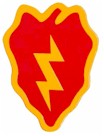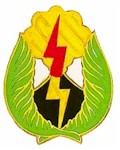FOURNIER, William G. [posthumously]
Rank and organization: Sergeant, U. S. Army, Company
M, 35th Infantry, 25th Infantry Division.
Place and date: 10 January 1943, Mount Austen, Guadalcanal,
Solomon Islands.
Citation: For conspicuous gallantry and intrepidity in
action at the risk of his life above and beyond the call of duty. Sergeant
Fournier was leader of a machine-gun section charged with the protection
of other battalion units, his group was attacked by a superior number of
Japanese, his gunner killed, his assistant gunner wounded, and an adjoining
guncrew put out of action. Ordered to withdraw from this hazardous position,
Seargeant Fournier refused to retire but rushed forward to the idle gun
and, with the aid of another soldier who joined him, held up the machinegun
by the tripod to increase its field action. They opened fire and inflicted
heavy casualties upon the enemy. While so engaged both these gallant soldiers
were killed, but their sturdy defensive was a decisive factor in the following
success of the attacking battalion. Sergeant Fournier’s selfless concern
for his comrades, and intrepidity at the cost of his own life above and
beyond the call of duty are in keeping with the highest traditions of the
military service and reflect great credit upon himself, his unit, and the
United States Army. |
HALL, Lewis [posthumously]
Rank and organization: Technician Fifth Grade, U.S. Army,
Company M, 35th Infantry, 25th Infantry Division.
Place and date: Mount Austen, Guadalcanal, Solomon Islands,
10 January 1943.
Citation: For gallantry and intrepidity above and beyond
the call of duty. As leader of a machinegun squad charged with the protection
of other battalion units, his group was attacked by a superior number of
Japanese, his gunner killed, his assistant gunner wounded, and an adjoining
guncrew put out of action. Ordered to withdraw from his hazardous position,
he refused to retire but rushed forward to the idle gun and with the aid
of another soldier who joined him and held up the machinegun by the tripod
to increase its field of action he opened fire and inflicted heavy casualties
upon the enemy. While so engaged both these gallant soldiers were killed,
but their sturdy defense was a decisive factor in the following success
of the attacking battalion. Technician Hall’s selfless concern for
his comrades, and intrepidity at the cost of his own life above and beyond
the call of duty are in keeping with the highest traditions of the military
service and reflect great credit upon himself, his unit, an the United States
Army. |
DAVIS, Charles W.
Rank and organization: Major, United States Army, 27th
Infantry, 25th Infantry Division.
Place and date: Guadacanal Island, 12 January 1943.
Citation: For distinguishing himself conspicuously by
gallantry and intrepidity at the risk of his life above and beyond the call
of duty in action with the enemy on Guadalcanal Island. On 12 January 1943,
Major Davis, then Captain, executive officer of an Infantry Battalion, volunteered
to carry instructions to the leading companies of his battalion which had
been caught in a cross fire from Japanese machine-guns. With complete disregard
for his own safety, he made his way to the trapped units, delivered the
instructions, supervised their execution and remained overnight in this
exposed position. On the following day, Major Davis again volunteered to
lead the assault on the Japanese position which was holding up the advance.
When his rifle jammed on its first shot, he drew his pistol and waving his
men on, led the assault over the top of the hill. Electrified by his action
another group of soldiers followed and seized the hill. The capture of this
position broke Japanese resistance and the battalion was then able to proceed
and secure the Corps objective. The courage and leadership displayed by
Major Davis inspired the entire battalion and unquestionably led to the
success of its attack. |
PARRISH, Laverne [posthumously]
Rank and organization: Technician 4th Grade, U.S. Army,
Medical Detachment, 161st Infantry, 25th Infantry Division.
Place and date: Binalonan, Luzon, Philippine Islands,
18-24 January 1945.
Citation: He was medical aid man with Company C during
the fighting in Binalonan, Luzon, Philippine Islands. On the 18th, he observed
2 wounded men under enemy fire and immediately went to their rescue. After
moving 1 to cover, he crossed 25 yards of open ground to administer aid
to the second. In the early hours of the 24th, his company, crossing an
open field near San Manuel, encountered intense enemy fire and was ordered
to withdraw to the cover of a ditch. While treating the casualties, Technician
Parrish observed 2 wounded still in the field. Without hesitation he left
the ditch, crawled forward under enemy fire, and in 2 successive trips brought
both men to safety. He next administered aid to 12 casualties in the same
field, crossing and re-crossing the open area raked by hostile fire. Making
successive trips, he then brought 3 wounded in to cover. After treating
nearly all of the 37 casualties suffered by his company, he was mortally
wounded by mortar fire, and shortly after was killed. The indomitable spirit,
intrepidity, and gallantry of Technician Parrish saved many lives at the
cost of his own. Technician Parrish’s selfless concern for his comrades,
and intrepidity at the cost of his own life above and beyond the call of
duty are in keeping with the highest traditions of the military service
and reflect great credit upon himself, his unit, and the United States Army. |
McGAHA, Charles L.
Rank and organization: Master Sergeant, U.S. Army, Company
G, 35th Infantry, 25th Infantry Division.
Place and date: Near Lupao, Luzon, Philippine Islands,
7 February 1945.
Citation: He displayed conspicuous gallantry and intrepidity.
His platoon and 1 other from Company G were pinned down in a roadside ditch
by heavy fire from 5 Japanese tanks supported by 10 machineguns and a platoon
of riflemen. When 1 of his men fell wounded 40 yards away, he unhesitatingly
crossed the road under a hail of bullets and moved the man 75 yards to safety.
Although he had suffered a deep arm wound, he returned to his post. Finding
the platoon leader seriously wounded, he assumed command and rallied his
men. Once more he braved the enemy fire to go to the aid of a litter party
removing another wounded soldier. A shell exploded in their midst, wounding
him in the shoulder and killing 2 of the party. He picked up the remaining
man, carried him to cover, and then moved out in front deliberately to draw
the enemy fire while the American forces, thus protected, withdrew to safety.
When the last man had gained the new position, he rejoined his command and
there collapsed from loss of blood and exhaustion. M/Sgt. McGaha set an
example of courage and leadership in keeping with the highest traditions
of the service. |
COOLEY, Raymond H.
Rank and organization: Staff Sergeant, U. S. Army, Company
B, 27th Infantry, 25th Infantry Division.
Place and date: Near Lumboy, Luzon, Philippine Islands,
24 February 1945.
Citation: For conspicuous gallantry and intrepidity in
action at the risk of his own life above and beyond the call of duty. S/Sgt.
Cooley was a platoon guide in an assault on a camouflaged entrenchment defended
by machineguns, rifles, and mortars. When his men were pinned down by 2
enemy machineguns, he voluntarily advanced under heavy fire to within 20
yards of 1 of the guns and attacked it with a hand grenade. The enemy, however,
threw the grenade back at him before it could explode. Arming a second grenade,
he held it for several seconds of the safe period and then hurled it into
the enemy position, where it exploded instantaneously, destroying the gun
and crew. He then moved toward the remaining gun, throwing grenades into
enemy foxholes as he advanced. Inspired by his actions, 1 squad of his platoon
joined him. After he had armed another grenade and was preparing to throw
it into the second machinegun position, 6 enemy soldiers rushed at him.
Knowing he could not dispose of the armed grenade without injuring his comrades,
because of the intermingling in close combat of the men of his platoon and
the enemy in the melee which ensued, he deliberately covered the grenade
with his body and was severely wounded as it exploded. By his heroic actions,
S/Sgt. Cooley not only silenced a machinegun and so inspired his fellow
soldiers that they pressed the attack and destroyed the remaining enemy
emplacements, but also, in complete disregard of his own safety, accepted
certain injury and possible loss of life to avoid wounding his comrades. |
| 01.10.1941 |
Maj.-Gen. Maxwell Murray |
| 29.04.1942 |
Brig.-Gen Stanley E. Reinhart |
| 08.05.1942 |
Brig.-Gen. J. Lawton Collins |
| 26.05.1942 |
Maj.-Gen. J. Lawton Collins |
| 18.12.1943 |
Brig.-Gen. Charles L. Mullins (Jr.) |
| 24.02.1944 |
Maj.-Gen. Charles L. Mullins (Jr.) |
| 12.06.1944 |
Brig.-Gen William B. Bradford |
| 00.00.0000 |
Maj.-Gen. Charles L. Mullins (Jr.) |
| 01.09.1944 |
Brig.-Gen William B. Bradford |
| 00.00.0000 |
Maj.-Gen. Charles L. Mullins (Jr.) |
| 03.09.1944 |
Brig.-Gen. William P. Bledsoe |
| 00.00.0000 |
Maj.-Gen. Charles L. Mullins (Jr.) |
| 22.10.1944 |
Brig.-Gen. William P. Bledsoe |
| 00.00.0000 |
Maj.-Gen. Charles L. Mullins (Jr.) |
| 11.11.1944 |
Brig.-Gen. William P. Bledsoe |
| 00.00.0000 |
Maj.-Gen. Charles L. Mullins (Jr.) |
| 30.06.1945 |
Brig.-Gen Everett E. Brown |
| 00.00.0000-End of War |
Maj.-Gen. Charles L. Mullins (Jr.) |



